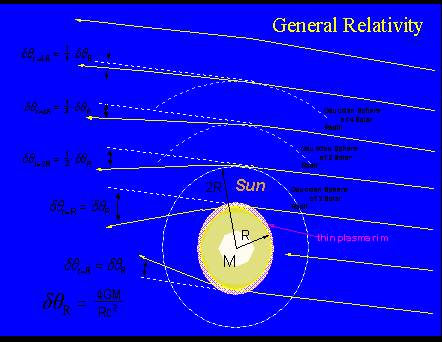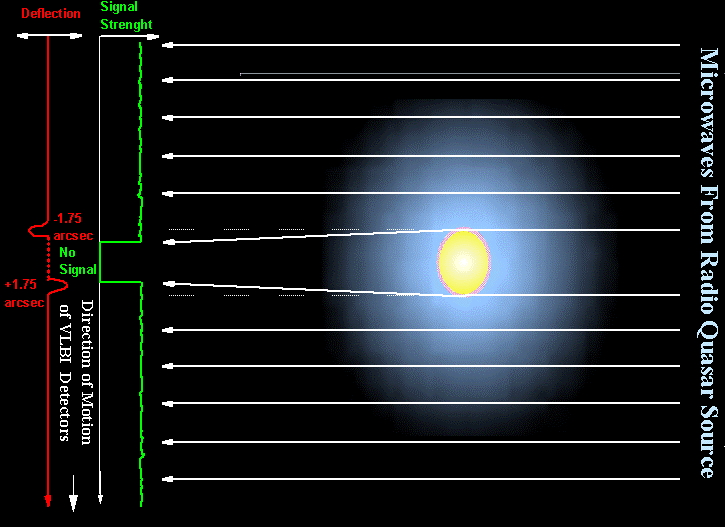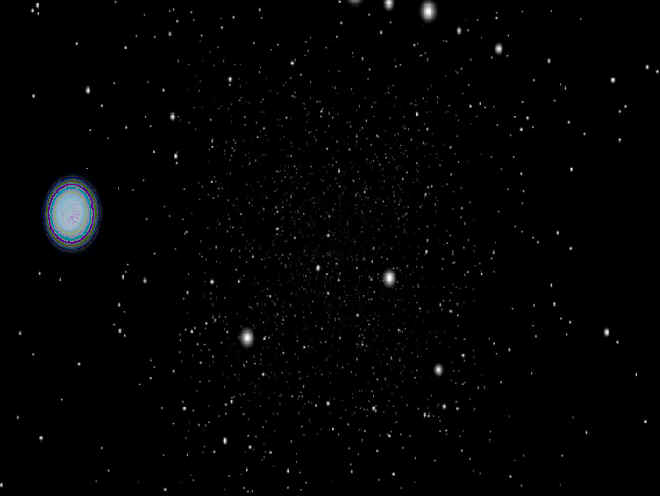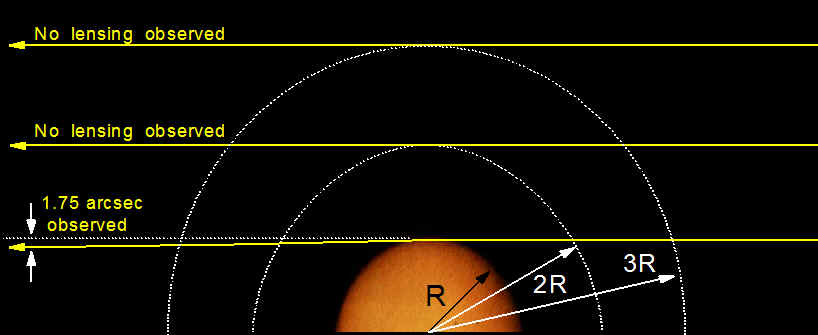|
Gauss's Law of Gravity
applied to Solar Plasma Limb
|
Burning Question |
|
Why are the Einstein
Rings not seen in the star-filled skies? |

|
| Fig 4C |
| Solar light
bending as function of the impact parameter |
|
R {at
solar plasma limb},
2R, 3R,
4R,
etc,
|
|
|
|
"The Observations"
|
versus
|
"General Relativity"
|
|
explainable with least-time or minimum-energy waves in a plasma exposed to solar gravitational gradient field
|
an assumption of space-time effects or curvature of space
to explain gravitational light bending
|
|
Fig 4D: Solar
Light Bending according to a Century of Observations |
|
Gravitational light bending, as predicted by
General Relativity, should be easily noticeable at multiple solar radii well
into the empty vacuum space above the solar plasma rim as depicted in Figure 4D, at impact parameters of
2R, 3R, . . , nR, where R = 695,500 km is one solar radius, M is the solar mass enclosed
whose center of mass is concentric to the Gaussian spheres.
Since the light bending rule of General Relativity is essentially a 1/R effect,
modern technical means in Astrophysics should permit us to easily detect a light
bending effect at the impact parameters listed.
|
|
| Gravitational
Deflection as function of Impact Parameter |
| (in
units of the solar radius R) |
| Impact Parameter
(solar radii R) |
Observational History (arsec) |
General Relativity (arcsec) |
| R |
1.75 |
1.75 |
| 2R |
<
0.875 to negligible |
1/2 of 1.75 |
| 3R |
negligible |
1/3 of 1.75 |
| nR |
not
observed |
1/n of 1.75 |
|
|
Remarkably as it may seem, however, historically the solar light
bending effect has been observed only at the solar rim, the refractive plasma
atmosphere of the sun. This is strongly confirmed by a large number of
very-long-baseline-interferometer (VLBI) measurements on the gravitational deflection of microwaves from radio pulsar sources that were deflected at the
thin plasma rim of the sun at precisely the angle of 1.75 arcsec. See
the illustration in Figure 10.
The observed solar grazing effect of
rays of star light at the thin plasma limb (a thickness that is greatly
exaggerated here) is depicted in the following animated
illustration:
|

|
Fig
5
Animated Image is taken from
|
|
|
|
|
It
is
interesting to note that the focal length F
of the sun of
radius R is
determined to be roughly 550 astronomical units (AU's), nearly 14 times the mean
orbital radius of Pluto, according to the equation

The focal length F and the radius R
of the sun are expressed in the same units. As depicted in Figure 7, the light
rays from a distant star will come to a focus at a distance of roughly 550 AU's, assuming a convergence angle of 1.75 arcsec. It has been a long
desire of many
astrophysicists, to include SETI study groups and the International Academy of
Astronautics, to send spacecrafts loaded with observational instruments 550 AU's
out to the focal point of the solar plasma lens.
|
|
The
Focal Length of the Plasma Limb of a Sun-like Lensing Star |
|
{assume
all light rays are coming from sources at infinite distances} |
|

|
 observed
at plasma focus
observed
at plasma focus
|
|
Fig 6
Einstein Ring as would be seen at Plasma Focus of the Sun |
|
| Any sun-like star of 1
MSUN and 1 RSUN
will deflect starlight at 1.75 arcsec at the minimum impact
parameter corresponding to the thin plasma limb of that star. The stellar plasma
limb of any such lensing star will deflect light of a distant stellar light
source. The lensed light rays will come to a focus at a distance of approximately 550
AU's from the lens. Enormous observational evidence
supports an "indirect" interaction (not
a "direct" interaction) between the
gravitational gradient field of the lensing sun or stars acting on the
plasma limbs which in tern acts on the rays of starlight; thus, an
"indirect
interaction" between the
gravitational gradient field of the lensing star and the light rays of
distant stars. The visibility of Einstein Rings produced
by deflected light rays at impact parameters corresponding to the
plasma limbs of stars is consistent with all observations. |
|
|
Gravitational
Deflection as function of Impact Parameter |
|
Supported
by History of Observational Evidence |
|
{assume
all light rays are coming from sources at infinite distances} |
|

|
High
Impact Parameter

Einstein
Rings NOT OBSERVED |
|
Fig 7
GRAVITATIONAL
DEFLECTION as function of IMPACT PARAMETER (The Evidence) |
-
At
the plasma limb of the sun and the stars,
historically, the gravitational deflection of
light and microwaves are clearly observed.
-
At
high impact parameters significantly greater than
1 solar radius and 1 stellar radius, i.e., in the
plasma-free vacuum space above the sun and stars,
the observed bending of stellar light rays are
found to severely deviate from the light bending
rule of General Relativity.
-
In
the star-filled skies, Einstein Rings produced by
high impact parameter light rays are yet to be
observed. In this region in the plasma-free vacuum
space, the bending of stellar light rays are yet
to be observed.
|
|
| |
|
The Observations |
|
The gravitational light bending effect
of 1.75 arcsec is constantly being observed at the solar
plasma limb and is predicted to come to a focus at 550 AU's. It
is predicted by a pure classical least-time / minimum-energy
calculation which is independent of the assumptions of General
Relativity. The plasma-limb deflection of 1.75 arcsec has been confirmed by a host of
VLBI measurements on
microwaves emitted from extra galactic quasar radio sources.
At the analytical Gaussian sphere of 2 solar radii the rays of
starlight is predicted by General Relativity to be deflected at an angle of 0.875 arcsec
which will come
to a focus at a factor of 4 times 550 AU's or 2200 AU's. At this
impact parameter, there is poor agreement with General Relativity for
both starlight and microwaves.
At the
analytical Gaussian sphere of 3 solar radii General Relativity
predicts a deflection of 0.583 arcsec which will come to a
focus at a factor of 9 times 550 AU's
or at a focal length of 4950 AU's. At this impact parameter and beyond
there is very poor to no agreement at all with General
Relativity. |
| |
|
A clear fact supported by
observational evidence: An
Einstein Ring produced by light rays passing at high impact
parameters, i.e., passing clearly above the lensing star in a
plasma-free vacuum space, i.e., at impact parameters of multiple
stellar radii is yet to be observed. A sun-like lensing star of 1
solar mass and 1 solar radius will deflect rays of starlight at 1.75 arcsec
which will come to a focus at approximately 550 AU's.
|
|
|
|
Gravitational
Deflection Predicted by General Relativity |
|
{assume
all light rays are coming from sources at infinite distances} |
|

|
NO
EVIDENCE
for
Einstein
Rings
from high
impact parameter rays |
|
Fig 8
Gravitational
Deflection Predicted by General Relativity |
|
A minimum-energy
calculation shows that electromagnetic waves propagating in a plasma
atmosphere exposed to the gravitational gradient field of sun will
deflect precisely at the angle of 1.75 arcsec at an impact parameter
corresponding to the plasma limb of the sun. This was accomplished
from pure classical assumptions of a minimum-energy or least-time path
of electromagnetic waves propagating in a plasma atmosphere exposed to
the gravitational gradient field of sun. The results was published for
the very first time in the book "Discourses &
Mathematical Illustrations pertaining to the Extinction Shift
Principle under the Electrodynamics of Galilean Transformations". The least-time calculation
has been confirmed by a host of long-base-interferometer measurements
of microwaves from radio pulsar sources that were deflected at the
thin plasma rim of the sun at precisely the angle of 1.75 arcsec. (For
details on this subject matter see Topic 10
"PUBLICATIONS" under
Menu of Significant Findings).
As already stated, a history of
VLBI measurements have recorded a plasma-limb deflection of microwaves at
exactly 1.75 arcsec of microwaves emitted from extra galactic quasar radio
sources. At astronomical distances the rays of microwaves are
virtually parallel with one another as can be detected by modern
astronomical instruments as depicted in Figure 9. As the VLBI
detectors involving microwave antennas stationed on Earth based
observatories move along an Earth orbit, the gravitational deflection of
the rays of microwaves are recorded by researchers conducting these
experiments. Historically, the rays of
microwaves are observed to deflect only at the angle of 1.75 arcsec,
which corresponds to an impact parameter of exact one (1) solar radii
or R = 695,500 km. Only at this impact parameter will any star of one
solar mass and one solar radius theoretically deflect a ray of
microwaves according to the light bending rule of General Relativity
at the angle of 1.75 arcsec. If the light bending rule of General
Relativity were actually valid then a gravitational deflection of microwaves
should also be observable at other impact parameters, namely, at the
impact parameter of 2R to reveal a gravitational deflection of exactly
0.875 arcsec, at 3R to reveal a gravitational deflection of exactly 1/3 of 1.75
arcsec, etc., etc.
Historically, deflections of microwaves
are yet to be recorded at impact parameters greater than that of the
solar radius R to observe deflections at angles less than that of 1.75
arcsec.

| Fig 9
Microwaves
from Radio Quasar Sources deflected only at the Solar
Plasma Limb |
| observed to deflect only at the angle of exactly 1.75 arcsec |
| only at the impact parameter
of one (1) solar radius R |
Also assuming the validity of the light bending
rules of General Relativity, the rays of starlight at high impact
parameters relative to the lensing stars should produce Einstein rings
all over the night skies whose diameters are considerably larger than the
apparent disc size of the lensing stars. There are an infinite
number of light rays that could theoretically form an Einstein ring
given the
geometry of potential lensing stars and the position of an Earth based
Einstein ring
observer. The images of such Einstein rings in the star-filled night
skys should be easily detectable using modern
astronomical means. These Einstein rings are yet to be observed anywhere
in the star-filled skies using modern technical means.
|
|
|

|
|
Fig
10
Astrophysical evidence confirms
that the rays of starlight are lensed only at the plasma limbs of stars. If
the light bending rule of General
Relativity were indeed valid, which suggests a direct interaction
between gravitation and electromagnetism, then all Astrophysical
observations of deep space would be totally denied to all modern Astronomy. The deep
space images and the Astrophysics thereof would be completely blurred and filled
with Einstein rings and arcs.
|
|
Burning Question that's
no longer Burning |
|
Where
are the Einstein Rings among the star-filled skies? |
|
PREVIOUS
PAGE
NEXT
PAGE
RETURN
TO MENU
|





 observed
at plasma focus
observed
at plasma focus



